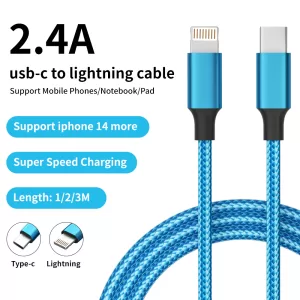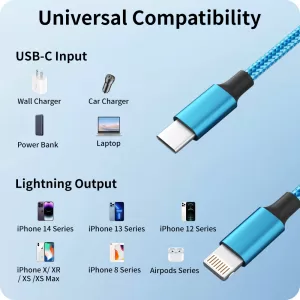In the world of technology, connectivity and compatibility between devices are crucial for a seamless user experience. One of the most essential tools for modern-day device connectivity is the USB-C to Lightning cable. This cable plays a vital role in linking Apple’s ecosystem of products with other devices, ensuring efficient data transfer and charging capabilities. This article delves deep into the USB-C to Lightning cable, exploring its functionality, benefits, and why it has become a must-have accessory for many users.
Understanding USB-C and Lightning Connectors
Before diving into the specifics of the USB-C to Lightning cable, it’s important to understand what USB-C and Lightning connectors are.
USB-C: Universal Serial Bus Type-C (USB-C) is a relatively new industry-standard connector for transmitting both data and power through a single cable. It is characterized by its slim, reversible design, allowing users to plug it in either way, eliminating the frustration of incorrect orientation. USB-C is used across a wide range of devices, including laptops, smartphones, tablets, and gaming consoles, and is praised for its fast data transfer rates and high power delivery.
Lightning Connector: Developed by Apple, the Lightning connector is a proprietary interface used to connect Apple devices such as iPhones, iPads, and iPods to host computers, external monitors, cameras, USB battery chargers, and other peripherals. Unlike USB-C, the Lightning connector is slimmer and smaller, designed specifically for Apple’s ecosystem. It is reversible like USB-C, but it is only compatible with Apple devices.
What Is a USB-C to Lightning Cable?
A USB-C to Lightning cable is a hybrid cable that features a USB-C connector on one end and a Lightning connector on the other. This cable is designed primarily for connecting Apple devices (that use the Lightning port) to devices that have USB-C ports, such as newer MacBooks, iPads, and various third-party chargers. The primary purposes of the USB-C to Lightning cable are charging and data transfer between compatible devices.
Key Benefits of Using a USB-C to Lightning Cable
1. Faster Charging Speeds
One of the most significant advantages of using a USB-C to Lightning cable is faster charging speeds. When paired with a compatible USB-C power adapter (like Apple’s 18W, 20W, or higher chargers), the cable enables fast charging for iPhones and iPads. This allows users to charge their devices up to 50% in just 30 minutes, significantly reducing the time spent waiting for a full charge.
2. Improved Data Transfer Rates
The USB-C to Lightning cable also supports faster data transfer rates compared to older USB-A to Lightning cables. This is particularly useful when transferring large files, such as videos or high-resolution photos, between devices. Whether you’re backing up your iPhone to your MacBook or transferring data to another device, the improved speed can save time and increase productivity.
3. Versatility and Convenience
This cable bridges the gap between Apple’s proprietary Lightning technology and the more universal USB-C standard, making it versatile. It can be used with a wide range of devices, from iPhones to iPads and even USB-C-equipped laptops. The convenience of having a single cable that works across multiple platforms reduces clutter and the need for multiple different cables.
Compatibility and Limitations
While the USB-C to Lightning cable offers numerous benefits, it’s essential to understand its compatibility and limitations.
1. Device Compatibility
The USB-C to Lightning cable is compatible with a wide range of Apple devices, including:
iPhones (iPhone 12 and later)
iPads (iPad mini 4, iPad Air, iPad Pro models)
iPods (iPod touch 7th generation)
It is also compatible with USB-C chargers and devices, including:
USB-C-equipped MacBooks (MacBook Air, MacBook Pro)
USB-C iPad models (iPad Pro 11-inch, iPad Pro 12.9-inch)
Third-party USB-C power adapters
However, it’s important to note that this cable is not compatible with older Apple devices that use the 30-pin connector, nor can it be used with non-USB-C chargers without an appropriate adapter.
2. Limited Universal Compatibility
While the USB-C to Lightning cable is versatile within the Apple ecosystem, it may not be the best option for users with a mix of Apple and non-Apple devices. The cable cannot be used directly with devices that only support Micro-USB or older USB-A ports without additional adapters. This limits its universal applicability, especially for users who frequently switch between different ecosystems.
How to Choose the Right USB-C to Lightning Cable
When selecting a USB-C to Lightning cable, there are a few key factors to consider to ensure you get the best performance and value for your needs.
1. Length of the Cable
USB-C to Lightning cables come in various lengths, typically ranging from 1 meter (3.3 feet) to 2 meters (6.6 feet). The length you choose should depend on your usage needs. For instance, a shorter cable might be more convenient for travel or charging on the go, while a longer cable might be better suited for home or office use where outlets may be further away from your workspace.
2. MFi Certification
Apple’s MFi (Made for iPhone/iPad) certification is a key indicator that the cable meets Apple’s performance and safety standards. Non-certified cables might be cheaper, but they may not provide the same level of reliability, durability, or performance. Always look for MFi-certified cables to ensure compatibility and safety.
3. Build Quality
The durability of the cable is another crucial consideration. Some cables come with reinforced connectors or braided exteriors to resist wear and tear, making them more durable than standard cables. Investing in a high-quality cable can save you from the frustration of frequent replacements.
Future of USB-C to Lightning Cables
As technology continues to evolve, so does the landscape of device connectivity. The USB-C to Lightning cable currently serves as a critical link between Apple’s ecosystem and the broader world of USB-C devices. However, with growing adoption of USB-C across more devices, including within Apple’s product line (such as the iPad Pro and MacBook models), there is speculation that Apple may eventually transition entirely to USB-C connectors, phasing out the Lightning connector altogether.
If this shift happens, the USB-C to Lightning cable might become less relevant in the future, with a move towards more universal USB-C to USB-C connections. Nonetheless, for now, the USB-C to Lightning cable remains an essential accessory for many Apple users, providing the benefits of fast charging and data transfer in a convenient and reliable format.
Conclusion
The USB-C to Lightning cable is an indispensable accessory for Apple users, offering faster charging speeds, improved data transfer rates, and versatility across various devices. While it bridges the gap between Apple’s proprietary technology and the more universal USB-C standard, users should carefully consider compatibility and quality when choosing a cable. As technology continues to evolve, the relevance of this cable may shift, but for now, it remains a critical tool for modern device connectivity. Whether you’re a professional needing efficient data transfers or a casual user looking for quick charging, the USB-C to Lightning cable is a valuable addition to your tech arsenal.


